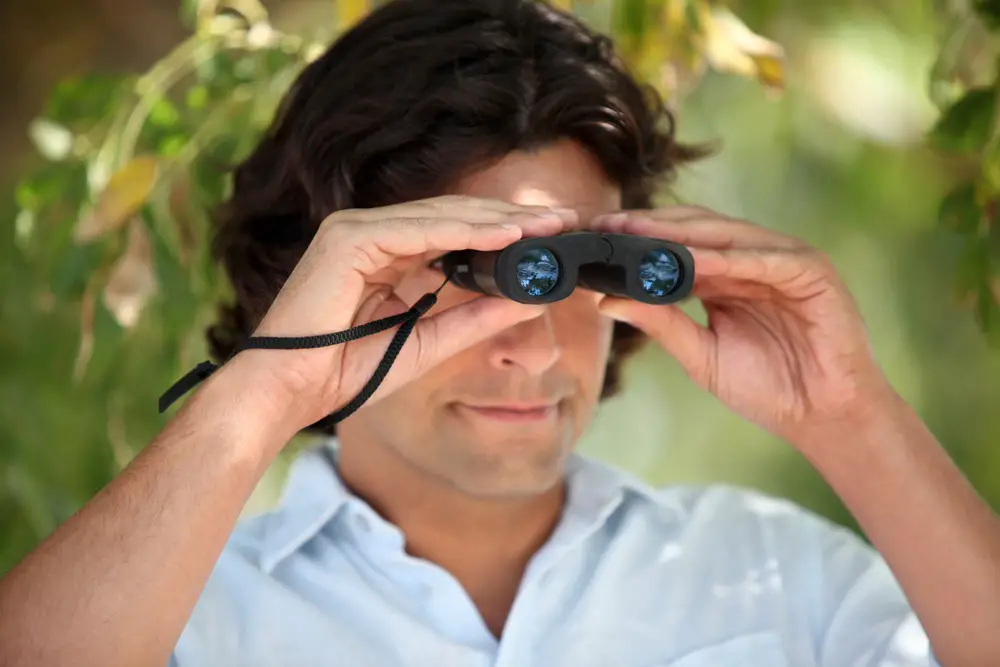
Unlike the large and quite heavy ones, my grandfather carries, its possible to get a great pair of binoculars that weigh only ounces and have excellent clarity and power. For hunters, scanning is much easier than with a spotting or rifle scope. And you never know what you may see out there.
At A Glance: Our Top 5 Picks for Compact Binoculars
- AMAZING IMAGE QUALITY: Steiner
- GREAT VALUE: Nikon
- EXCELLENT WARRANTY: Vortex Optics
- Zeiss
- Leupold
Top 5 Best Compact Binoculars (Summary)
For more detailed and complete product reviews on benefits and features, keep reading.
For anyone that enjoys activities that involve the great outdoors, anyone who enjoys fishing, hiking, and camping would almost always certainly have a binocular in their backpack. Binoculars are extremely useful in activities such as bird watching or hunting, and just as handy for mountaineering.
While this may be the case, early binoculars are huge and cumbersome affairs that many people often have to sacrifice other items and reach a compromise to make space for these useful items. If you want to experience being eye-to-eye with a deer or a wolf, looking at them with a binocular can be the next best thing.
If you want to take stock of your surroundings and have that situational awareness, a binocular can give you the information that you need.
The problem of bulk and weight gave rise to the popularity of what we now know as compact binoculars. While some may say that they do not have the same power as a regular-sized one, these are ultimately more portable and lightweight. They took away having to make a compromise on items to be carried because of their compact nature.
There is a compromise, though, and the caveat is that the zoom power may not be as powerful as a full-sized binocular. However, as manufacturing processes become even more advanced, even these smaller versions of the vaunted binoculars became at par with its bigger brother.
13 Best Compact Binoculars
1. Steiner Tactical 10x28 Compact Binocular
When it comes to binoculars, its hard to beat a company that has produced them almost exclusively for the last 75 years. When it comes to quality, reliability, and straight-up toughness, go with Steiner and you will never be disappointed. The larger and more powerful models have been a go-to for several militaries around the globe and are the current choice of the United States Coast Guard.
These are on the larger side of compact binoculars at just a little over 5” in length but for that, you get 10x binoculars with an amazing field of view and outstanding optical quality. All of the glass is multicoated and the lenses and prism are all of the absolute finest quality. For a 10x binocular you would never need anything more!
They may be a little large but weighing under a pound makes them easy to transport in a pocket or anywhere else. They are fully rubberized, tough as nails and nitrogen purged so you have no worries about what or fog. If you want binoculars that are built like a tank and still perform with precision, get a pair of Steiners!
Check Price and Rating on Amazon.com
Pros
- Amazing image quality
- Tough as nails
- Comfortable
- Mil-spec
Cons
- Expensive
- Somewhat large
2. Zeiss Terra ED Compact Pocket Binocular
The first pair of Zeiss binoculars was manufactured way back in 1894. I’m not sure how good the quality was but the craftsmanship back then was top notch. As a matter of fact, those binoculars still work to this day. If they could do that back then with some brass, glass, and solder, imagine what they can do now?
Well, what they can do is produce some absolutely stellar glass. Seriously, anything better would cost thousands of dollars and that’s no exaggeration. The high tech multicoated lenses and prism in a set of Zeiss are second only to companies that produce lenses for NASA. Out of an 8x binocular, you won’t believe how clear and bright an image you can get until you give these a shot.
Unlike a true field binocular, these aren’t the most rugged tool you can get for the money. They are water and fog proof, nitrogen purged and durable enough for pocket carry, they just aren’t what I would consider hard use gear. They are outstanding in all other regards.
Check Price and Rating on Amazon.com
Pros
- Outstanding image quality
- Comfortable to use
- Small size
Cons
- Expensive
- Could be more durable
3. Nikon ProStaff 7S Compact Binocular
Let’s not pretend that Nikon isn’t an absolute powerhouse in the world of optics. If it’s got lenses, Nikon makes and they make it very well with high quality material and premium glass that for the money is probably about the best you can get. This is especially true of the ProStaff series of optics.
Much like their rifle scopes, Nikon’s lenses in their binoculars have a baked on coating to improve the overall optical quality and brightness. Once added to their already high quality glass, it gets even better and even brighter. Dollar for dollar, I don’t think you do much better.
These 10x binoculars are small and weigh under a pound, making them very easy to transport but don’t sacrifice on toughness. With a nitrogen purged interior and shockproof rubber armor, these are great binoculars that will last a lifetime or more. For sheer value, this is the binocular to get!
Check Price and Rating on Amazon.com
Pros
- Great image quality
- Super rugged
- Small and light
- Great value
Cons
- Somewhat costly
- Small size can be hard to use
4. Leupold BX-1 Compact Binoculars
Every outdoorsman should treat themselves to a fine pair of binoculars, you never know when you may want or need them. In that case, consider treating yourself to these Leupold binoculars which I am pretty sure you will never see for this price again. These are a serious but attractive tool for the outdoors and carry the legacy of Leupold.
For a compact 10x binocular, these are a little long thought they are still narrow enough to fit a pocket easily. Packed into their 8” length is still some amazing quality glass just like you get in Leupold’s finest scopes. There are few companies that carry the reputation for quality that Leupold does and their phenomenal multicoated lenses are the primary reason why.
Not to skimp on durability, these are nitrogen purged, water and fog proof, the prism is phase coated, and the lenses are scratch resistant. On top of that, they are coated in an anti-shock gray rubber armor which adds a touch of flair. These are a very attractive binocular at an even more attractive price. Snatch these up before they are gone!
Check Price and Rating on Amazon.com
Pros
- Great optics
- Rugged and tough
- Easy to use
- Amazing value
Cons
- Not cheap
- Longer than most compact binoculars
5. Vortex Optics Vanquish Binoculars
You can’t possibly start looking at quality optics these days without looking at a Vortex. The mystery here is how Vortex has managed to pack this much quality in to so small a package and then sell it at such a low price. Whatever they are doing, they are doing it perfectly. Quality wise, these are better than some binoculars that cost twice the price.
These are the only porro prism binoculars on this list and while that won’t mean much to most readers, it does improve the quality of the image you get through these super small and amazingly light weight 8x binoculars. Like all Vortex optics, the glass is outstanding quality and fully multicoated inside and out before being sealed in the tubes which are then filled with nitrogen.
This makes the binoculars fog and waterproof for a lifetime of use. Add that to the rubberized coating for shock resistance and you have a tool that can handle any environment. For a binocular weighing less than a pound and only 4” long, what more could you possibly ask for? These are an amazing value!
Check Price and Rating on Amazon.com
Pros
- Superb image
- Built like a tank
- Amazing value
- Overall outstanding performance
Cons
- More sensitive parts
6. Wingspan Optics Spectator Compact Binocular
It’s probably time we had a newcomer. Most of the companies here have been around for ages and its good to have some new blood to keep things exciting and that is what Wingspan has done. While you won’t find the out of this world quality of some of the highest priced binoculars, you will absolutely find a usable tool that is rugged as can be and for a price that is almost unbelievable.
While the glass and prism themselves are very good quality, the lenses lack the multicoating that most companies offer. This does save on cost but hurts the brightness of the image. Wingspan’s answer to this was a larger objective lens which would normally make a larger binocular but these are still quite small and easy to carry in a pocket. The quality is still there and they are far better than any big box store binocular you are likely to buy.
Where the Spectators really shine is their durability. Fully water, fog, and dust proof for a start and quite resistant to shock as well. These should last a lifetime which is how long Wingspan warranties them for. If you break them, they replace them. For the price, what more could you ask for?
Check Price and Rating on Amazon.com
Pros
- Very affordable
- Quite robust and tough
- Comfortable
- Affordable
- Great warranty
Cons
- Image is a little off
- Large diameter can be harder to carry
- Some concern over lens seals
7. Adorrgon
Adorrgon Compact Binoculars offer 12x magnification. This includes an impressive 367 feet or 1000 yards in your field of view.
The lens uses both a 16.5mm BAK4 Prism and a multi-coated lens in each eyepiece. That design gives you clear, crisp images that you can depend on.
You can use these binoculars easily in low light thanks to the intuitive design. However, they still won’t offer additional “night vision” features allowing you to see in complete darkness.
The binoculars also come with several accessories to help you make the most out of the set. This includes a carrying case, lens covers, a cleaning cloth and a strap to wear them around your neck.
Check Price and Rating on Amazon.com
Pros
- Offers 12x magnification
- Anti-slip grip and rubber armor add to the durability
- Included carrying case, lens cover and cleaning cloth for cleaning
Cons
- Optics are slightly blurry at high zooms
8. SkyGenius
SkyGenius Compact Binoculars have an 8x magnification with a 369-foot or 1000-yard field of view. This is offered by a 21 mm objective lens and gives you a wide scope of view when you’re looking at something far away.
You can easily adjust the view with the center-focus knob. The knob has a straight-forward design and moves easily, making it a good pair of binoculars for kids as well as adults.
The lenses use both FMC multi-coated green film and BK7 Roof Prisms. These design features help you see better in low light and have a generally clear image as you use them.
The binoculars also come with a 12-month warranty that you can depend on if anything goes wrong. You can also depend on the SkyGenius customer support line which is available 24/7.
Check Price and Rating on Amazon.com
Pros
- Offers low light usability
- Center-focus knob makes it easy to adjust for both adults and children
- 1-month warranty
Cons
- No lens caps included
9. Occer
The design of Occer Compact Binoculars is small enough to carry in one hand. Weighing in at only 7.2 oz., they aren’t going to be a burden to carry around.
The binoculars use a 25 mm objective lens paired with a BAK4 Prism texture. This combination gives you a clear view even with a pocket-sized tool.
They also fold at the center. That design allows you to adjust the separation between each eyepiece until the binoculars fit your view comfortably.
They’re made for durability as well. They have an ABS plastic cover with non-slip rubber armor, so even if you drop them, they aren’t going to break easily which makes them a safe choice for kids as well.
Check Price and Rating on Amazon.com
Pros
- Work well in low light
- Small enough for single-handed use
- Durable and water-resistant
Cons
- Does not include a carrying case
10. Hontry
Hontry Binoculars magnify your field of view 10 times. Even better, this result is offered without blur or color changes.
This is, in part, thanks to the multi-coating that they have. This gives you an image that is bright, crisp and clear.
Their lightweight design is also a beneficial feature. Since it only weighs 0.6 lbs., you don’t have to worry about it being a burden to lug around on your day out.
The binoculars are coated with rubber armor. Aside from durability, this makes them much more ergonomic.
Check Price and Rating on Amazon.com
Pros
- Ergonomic design
- 10x magnification
- Rubber coating adds durability
Cons
- Sensitive to water damage
11. BRIGENIUS
BRIGENIUS Compact Binoculars use a large 42 mm objective lens and a 211-foot or 1000-yard field view. As for distance, these binoculars give you a 10x magnification.
The design uses BRIGENIUS smart design. This makes them moisture-resistant and dust-resistant. However, they aren’t completely waterproof nor suitable for conditions such as environments with heavy rain.
They’re also very helpful in low-light environment. They aren’t equipped with total night vision, but you’ll be able to see clearly in the early evening or on an overcast afternoon.
This model also comes with BRIGENIUS quality protection. If you run into an issue, you can contact them for a replacement or refund.
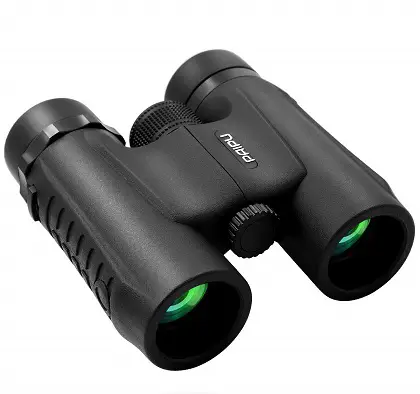
Check Price and Rating on Amazon.com
Pros
- Work well in low-light
- Moisture-resistant and dust-resistant
- Satisfaction guarantee
Cons
- Not completely waterproof
12. Allo
If you’re looking for a pair of binoculars that’s made to fit in your palm, Allo might be just what you’re looking for. A nylon mesh carrying case is also included to help you transport and store them.
They also have a 10x power magnification. Alongside this, they offer a large field view of 307 feet or 1000 yards.
The lenses are multi-coated and feature a large BAK-4 Prism. This makes sure you experience minimal distortion when you look through the eyepiece.
Allo has a 12-month warranty on these binoculars. They also offer 24-hour customer support that’s there whenever you need it.
Check Price and Rating on Amazon.com
Pros
- Small enough to fit in the palm of your hand
- Minimal view distortion
- 12-month warranty
Cons
- Don’t perform well in low-light conditions
What Are Compact Binoculars
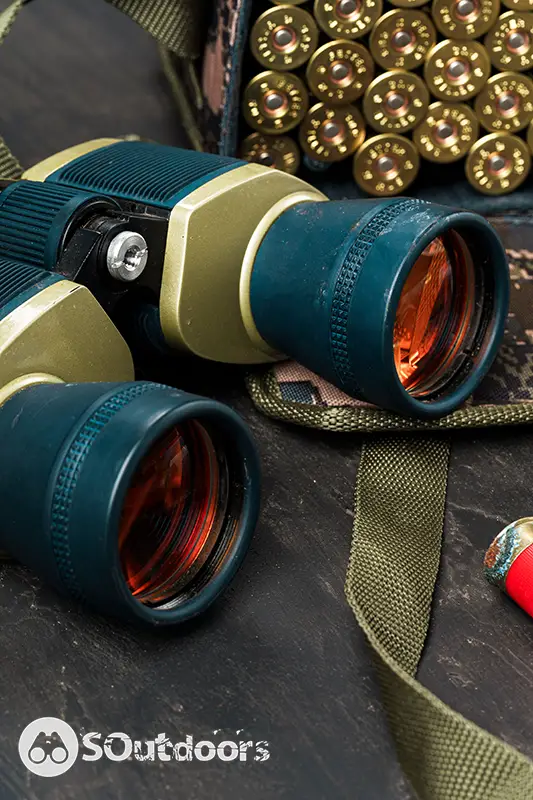
Generally, there are two kinds of scopes that can be used to see far away places. These are the monocular and binocular telescopes. Monocular scopes can be used with only one eye, and due to that restriction, they have challenges when it comes to depth of field.
Enter the binocular, which is essentially two monoculars joined together to produce images for both eyes. This allowed binoculars to have an advantage over its monocular cousin. However, old binoculars have a portability problem in which they have become too bulky and heavy to be called portable.
This ‘portability’ problem opened the way for the compact binocular. These are smaller than a regular field binocular but allows for almost the same area of view that its bigger brother can achieve. Their small size made them indispensable in any hiker, birdwatcher, or hunter’s backpack. Besides, because fewer materials are used, a compact binocular also costs less than its full-sized counterpart.
In less technical terms, the difference between a compact binocular and its larger brother is its size. However, both of these use almost the same lenses, prisms, and mirrors. Depending on the manufacturer, some even surpass their bigger counterparts in terms of quality and the durability of build. A compact binocular is, in its most basic description, a smaller version of the military’s field binoculars.
How Do Compact Binoculars Work
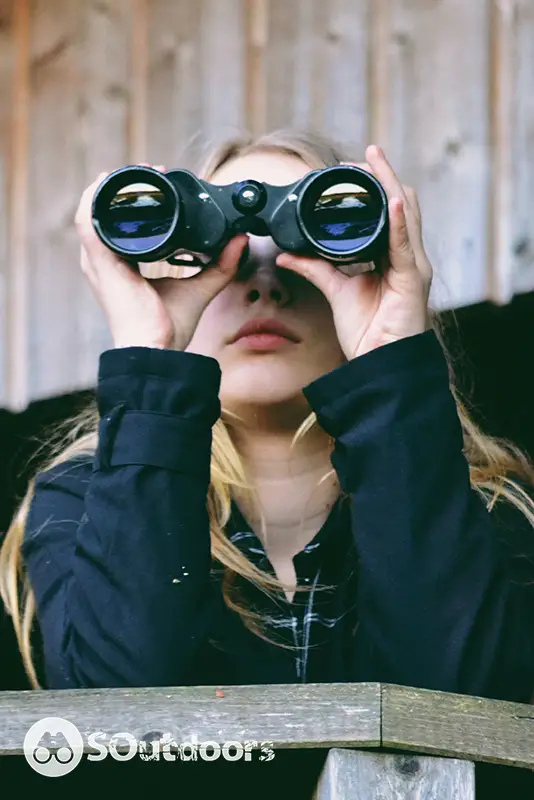
Binoculars are a result of advances made in the field of optics. They are magnification devices that can magnify and zoom in your field of view by a huge factor. They are not new either as the first binocular was first seen in the 1800s.
However, binoculars have come a long way from that time in terms of technology. Now we have night vision, digital additions, roof prism technology, and a host of different types of lens technology to tackle every scenario possible.
Binoculars take advantage of the light to achieve magnification. What happens inside a binocular is that it controls refraction via lens shape to achieve the manipulation of light to achieve magnification.
A binocular, whether regular-sized or compact, starts its light manipulation with two objective lenses. These two are the largest pieces of the lens in a binocular and they are made that way to gather as much light as possible.
After light gets into the objective lenses, they traverse what is called a focal path terminating into a focal point, where an eyepiece lens then captures it and then gives your eyes that magnified image. Lengthening this ‘focal path’ will result in greater magnification. However, a binocular is an already bulky item and elongating the distance from the objective lens to the eyepiece would seriously compromise its design.
To avoid lengthening the casing, the design incorporated what is known as Porro prism, and then afterward came the roof prisms. Both are designed to reflect the captured light to make its path longer to make the image larger without affecting the actual length of the casing.
These two have both their strong following, and both have their merits, as Porro prisms have higher magnification, and the depth and brightness of the Roof prisms are both highly coveted traits in a telescope.
The short version is that light comes into the objective lenses which are the largest pieces of glass in a binocular and are bounced around the prisms in a predetermined path. The captured light then finally arrives at the focal point and ultimately to your eyes via the eyepiece lenses. This means that the image you are looking at would have bounced around some time inside the binocular before reaching your eyes.
These magnification devices are not all lenses, though, and most have specialized features to enable them to be used across a variety of weather conditions such as extreme cold or heat and humidity. Some have multi-coating finishes on their lenses to ensure maximum image quality. Others have inert gases like argon or nitrogen filling up the interior to prevent the lenses from fogging up and making sure that the device is watertight.
Digital technology also made their way into these gadgets, making some higher-end compact binoculars into premium night vision goggles or an incredible thermal scope with amazing features and benefits. Their small size makes them ideal for hunters, who certainly need to bring night vision scope when hunting. However, all binoculars will have the same arrangement of lenses, and these additional features are just icing on the cake.
Pros and Cons of Compact Binoculars
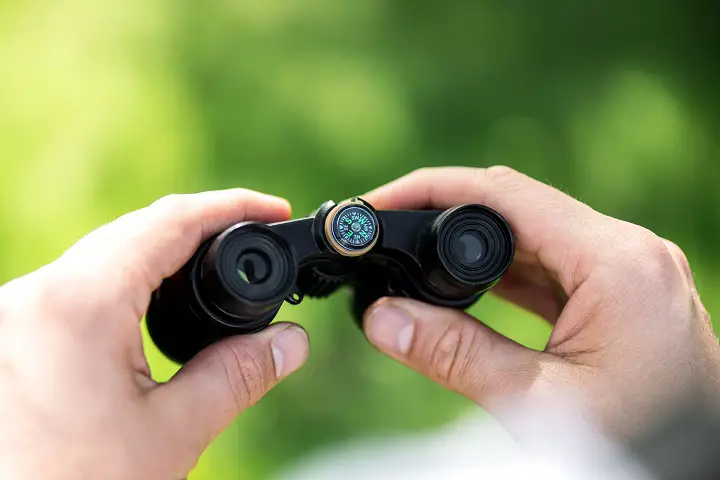
As a tool, compact binoculars are indispensable when it comes to hunting and outdoor activities, as well as bringing the action closer in large sporting or entertainment events. However, like everything else, they do have two sides to their story, and we give them a glance below.
Pros
Smaller Size
This is perhaps the single most compelling reason why compact binoculars are quite popular. Its smaller profile and build make it very handy to use, especially during those times that you need to whip one out real fast to be able to look at something. They are convenient when it comes to hunting and bird watching.
While there are binoculars that specifically apply to these activities, they may be too heavy and bulky to carry around while chasing a quarry. When hunting it is quite common to see hunters use a bow sight that works on long distances, some even use a red dot sight to increase percentages of a clean shot but even with these, they would still carry a compact binocular that is always within easy reach.
For many hunters, using crossbow scope for hunting along with a compact binocular is a winning combination that was made possible only with the compact size of these magnifiers. Hunters and birdwatchers in particular, who always carry a small cooler, an assortment of tools, their hunting gear, do not really want to add the bulk of a full-sized binocular and its case to their cargo.
Freedom from barrel distortion – The reduced barrel length is largely responsible for this, as well as the smaller diameter objective lenses. Not that, but the smaller overall size also minimizes flaring and barrel distortion.
Have a Better Edge Sharpness
The main reason for this is those smaller binoculars are more affordable to produce, and it goes the same for the lenses. Smaller diameter lenses are cheaper to produce so much so that even the best-crafted lenses in the compact binoculars are still cheaper than that of a regular-sized binocular. This results in more affordable compact binoculars but still having superior lens craftsmanship.
Relatively Lower Price
Once again the smaller size of the compact binocular results in a much lower production cost than a full-sized one. This translates to a relatively cheaper retail price, ultimately landing the benefits to the consumers. The other benefit is that even premium quality compact binocular will still be cheaper than its regular-sized counterparts by a huge margin while having almost the same level of performance.
Perfect for the Sports Enthusiast
The lower magnification power of the compact binocular, usually at 8X, allows them to be used for watching sports especially racing or fast-moving sports such as football or soccer. Their small size allows them to be whipped out at interesting parts of any game at a moment’s notice without breaking your arm off. Full-sized binoculars are not only large but quite heavy as well.
Cons
Less Than Ideal Resolution
The smaller openings by the objective lenses in a compact binocular is that it has somehow diminished capacity to provide a high-resolution image to the eye. Again, this is in relation to a regular-sized binocular and may not even be noticed by a casual user.
Bear in mind that the comparison is limited to all else being equal, meaning equal in terms of lens quality and other add-ons such as the addition of inert gasses. Good quality or a premium compact binocular can almost always outperform a cheaply made full-size binocular.
Prone to Eye Fatigue During Long Sessions
Because of the smaller objective lenses, the compact size of these binoculars works against them because it makes them prone to eye fatigue. The reason is that just a little bit off-centered when focusing the eyepieces can be extremely fatiguing to the eye.
This includes minute adjustments to the distance between both eyes, and to avoid fatigue, and they have to be perfect. Because of this, a full-sized binocular is recommended for long sessions.
Lower Image Brightness
This is relative to regular and full-sized binoculars, mainly because of the size of the objective lenses. However, this is often an exaggerated difference between the two sizes, and in reality, a compact binocular can offer the same brightness throughout the day and will only be beaten when it becomes dark enough to use artificial light sources.
A higher magnification compact binocular is hard to stabilize – when it comes to compact binoculars, less is actually more, especially when talking about magnification power a 10X power compact binocular is extremely hard to steady, often requiring the need to prop it somewhere to steady it. To maximize its use, it is better to opt for an 8X power as the maximum for a compact binocular.
What Makes the Best Compact Binoculars
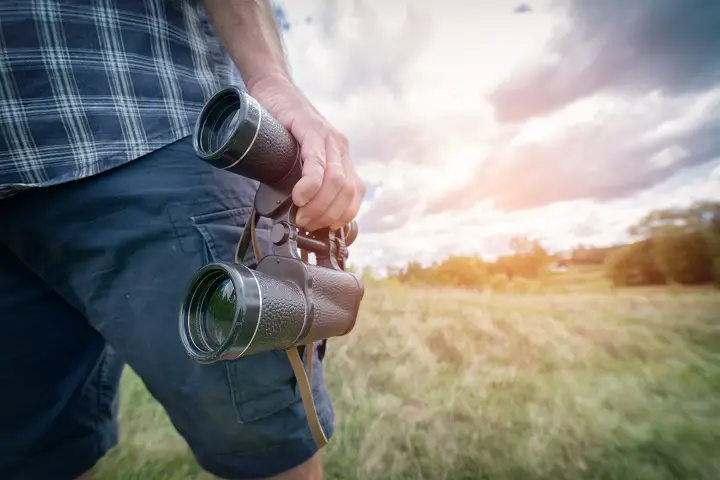
When it is time for you to choose your binocular, perhaps the single most important consideration is to make sure that your reason for buying it is clear. How are you going to use it and where you will be using them are important factors to know before selecting what binocular to buy. We want to save you the hassle of building a checklist so we took the trouble of building one for you below.
Power
The whole reason we want a pair of binoculars is for magnification. Having something with sufficient power to make a difference is a mandatory requirement. That said, you don’t need something super powerful. Your rifle scope or spotting scope is a much better tool for the details but having something of moderate power to aid in quickly scanning an area should be your goal.
I prefer something between 8x and 12x. It gives enough detail to see what you need to see but a large enough field of view to make scanning much easier. If you go any lower, you will likely not see enough benefit to binoculars over your naked eye and if you go much higher, you will be too close to a spotting scope. Keep it reasonable.
Weight and Size
The biggest advantages of today’s compact binoculars are weight and size. Having something that can fit in your pocket while being so light that you almost forget they are there is a great advantage. I used to carry a large pair around my neck and they did very little more than get in the way.
Some of the most compact binoculars today may only weigh as 5 or 6 ounces and be only a little larger than a deck of playing cards. You can fit them in any pocket and never even realize you are carrying them. If the goal is to make this an indispensable tool for the outdoorsman, weight and size will always be a primary consideration.
Ruggedness and Weatherproofing
Having any outdoor tool that can’t handle the environment is a no-go. As outdoorsmen, we need to demand quality, durability, and longevity in all of our gear. Some of the cheaper binoculars may have sufficient power and weight but if they can’t stand up to rain, mud, and getting dropped from time to time, none of that matters.
The best you can get will have a sealed and purged interior with some form of rubberized armor. They will be water, fog, and shockproof. These are the binoculars that will last a lifetime and the ones you should be looking closely for.
Optical Quality
I save this for last, not because it isn’t important, but because of its often not the primary feature of binoculars. Truth be told, you can deal with less optical quality out of binoculars than you could out of a rifle scope or spotting scope. They aren’t intended for seeing fine details.
That said, you should still get the best glass you can get. Look for binoculars that have multicoated lenses and a reputation for good craftsmanship. Chances are if they make a good scope, they make good binoculars. Leave the budget models at the big box stores alone, they often aren’t worth it.
Binocular Sizing
When it comes to sizing, binoculars are classified by a set of numbers and they go as a set such as 8 X 40 or 7 X 35. Note that the first number indicates the strength of the magnification and in the case of the examples, the 7 or 8 indicates that the object you are viewing is magnified seven or eight times respectively. The number following those would be the size of the objective lens.
These lenses are the largest lenses in binoculars. The larger the number, the bigger the lens and this directly translates to how much light is entering the eyepiece at the focal point. The bigger the number, the brighter the images will be when you look through them.
There is an additional number that is used when the particular binocular is a zoom binocular, meaning that it has multiple magnification power that can be adjusted. For example, a binocular with a number that goes 10-22-50mm will mean that you can adjust the magnification from 10 to 22 times with a 50mm objective lens size. These are more common among full-sized binoculars and rare in compacts.
Field of View

This refers to the viewable area that can be seen through the binoculars. In general, the higher the magnification power of a binocular, the smaller the field of view is because it will be zoomed in. Lower power binoculars will have the opposite as true as they would appear to be zoomed out.
They are measured by how wide the area is by how far they are to the user of a telescope. As an example, if you are looking at 2 trees that are 200 feet apart at a distance of 1000 yards, your field of view would be 200ft@ 1000 yards.
Lens Coatings
These are specialized coatings that are added on to the glass usually to prevent glare when looking at bright objects, such as a setting sun over an expanse of a lake. Without the coating, all you will probably see are glare. The coatings can be a single coating or multiple coatings to handle different levels of light and all are designed to make sure enough light reaches your eyes to be visible without the glare.
There are currently four levels of coating and the more coatings your binoculars have the more expensive they become. They are the following
- Coated – single layer of coating on at least the objective lenses
- Fully-coated – all air-to-glass surfaces have a single coating
- Multi-coated – Multiple coating on at least the objective lenses
- Fully Multi-coated – all air-to-glass surfaces have multiple coatings
Glass Types Used in Lenses
Much in the same manner as eyeglasses the quality and workmanship in the glasses used in making the binocular make a huge impact in its performance. Below are the types of glasses used in making a compact binocular.
BK7 Glass
Without this glass, most binoculars compact or no would be priced astronomically. BK7 is a high-quality optical glass that performs well in chemical tests and requires no additional special handling and this made the costs of manufacturing low. In addition, this glass has very low bubble inclusion content providing it with excellent light transmittance.
BAK-4 Glass
This glass is of a higher density and quality than the BK7 glass, most notable are the circular exit pupils versus the squared-off exit pupils of the BK7 BAK-4 glass is used mostly on higher-end compact binoculars due to their slightly higher pricing, but ultimately better performance especially in low light conditions.
ED Glass
ED refers to extra-low dispersion glass lenses developed by Nikon. Ordinary glass has no capacity to filter out the secondary spectrum of lightwaves and therefore cause distortion along the edges of the image being viewed. This effect is called chromatic aberration and these extra-low dispersion glasses lower the distortion to a considerable and barely noticeable degree.
Schott ED Glass
This also features the extra-low dispersion technology that Nikon’s ED glass offers but with the backing of german engineering and technology behind it. They have the advantage of also being a high-definition glass while being extra-low at the same time and that puts them at a higher notch above the rest.
Fogproof Inert Gas
This is a relatively new technology in terms of keeping out fog in our precious binoculars. Fog inside a binocular can quickly ruin a planned trip and leave you frustrated on a bird-watching adventure. In simple terms, this is the removal of oxygen and replacing the inside of a binocular with an inert gas such as argon or nitrogen.
Inert means that these gases rarely react to anything that they encounter especially temperature. Nitrogen and argon are the most commonly used gases in implementing this fog proofing technique. When choosing, know that nitrogen has smaller molecules and argon has a bigger molecule composition thus making it less likely to leak. Argon is also more expensive than nitrogen.
Prism Types
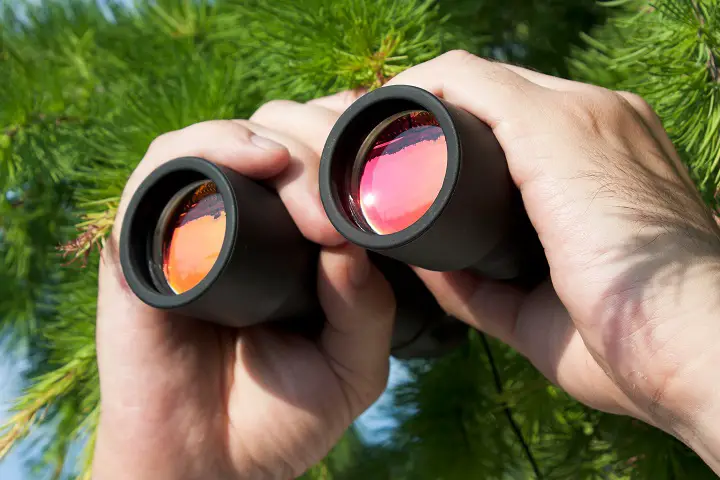
The prism system dictates how many times the light that enters are ‘elongated’ inside the binocular. Prisms act like mirrors and they are responsible for correcting the images and converting them to an image that can be seen by our eyes in the correct orientation. Without prisms, the image that we will see behind the objective lens would be inverted. There are two kinds of prisms used in binoculars and both have their own advantages.
Porro Prism
This kind of prism, when used in binocular, produces that distinctive profile wherein the prisms are offset from the objective lenses. They often result in a bigger profile than those that are equipped with roof prism type lenses. However, these prisms more than make up for the additional bulk by providing greater depth perception and a wider field of view.
Roof Prism
The system used in a roof prism assembly made the compact binocular even more compact by aligning the prisms directly behind the objective lenses making the tubes slimmer and in a straight line. Generally, this type of prism produces a smaller field of view than a Porro prism system.
Brand
The brand is something that may be quite subjective for most people but researching the brand is very important. There are brands that are very good at producing an entirely different kind of product and may just be venturing into the world of optics. These brands may have been around for a long time but have just begun to produce binoculars.
It is of paramount importance to know these things before basing your selection on a brand. By researching the brand you will come across on their reputation, how long they have been producing similarly oriented products, how people are reacting to their products, and more importantly, how they are treating their customers.
Comfort
Compact binoculars are made for casual use as the way they are designed makes them inherently eye fatiguing. When looking for these kinds of binoculars, the only way to be sure is to test each of your prospective products out until you have reached that level where you can tell which one is the most comfortable to use.
Most of the compact binoculars now have features that cater to those who are wearing glasses. These would have eyecups that retract. The most comfortable ones would have durable and multi-adjustable eyecups.
Durability
How the product would hold in the course of its day-to-day usage is a big factor when choosing an item and this is even truer in the case of the compact binocular. In its lifetime, a compact binocular will be prone to drops and bumps and it is quite important to consider what are the safeguards that are implemented in the product to prevent them from breaking up the first time it drops.
Armoring plays an important role in how durable the compact binocular can be when subjected to the most abusive use. Not only will it protect the item but it will also make the compact binocular comfortable to hold as most of it would be shock absorbent rubber.
Also, pay attention to the waterproof rating of the binoculars because the more protected it is against water, you can be assured that it is also protected against dust. Almost all compact binoculars have this feature.
Harness
Not all the compact binoculars that you purchase would have a harness that is included with it. The good news is that there is a ton of options when it comes to aftermarket harnesses that one can use for their compact binoculars. Choose one that has sufficient padding with easy to release straps and has multiple points of adjustments to ensure the correct fit.
Exit Pupil
The exit pupil when measured is the effective diameter of the objective lens divided by its magnification. The larger the diameter of the exit pupil is, the brighter the view field is and the clearer the picture would be. When choosing a binocular take stock of when you will be using it, because if you will be using it mostly at night, a larger exit pupil may be what you need.
How to Use Compact Binoculars
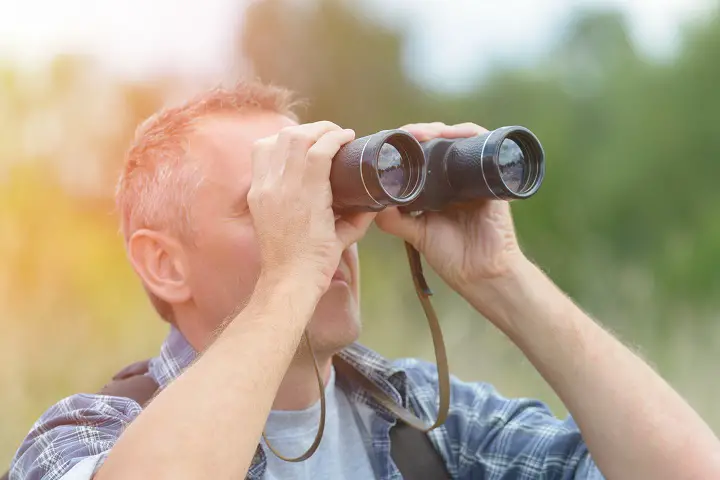
These are the steps to get the most out of your compact binoculars, certain preparations need to be undertaken to ensure that your gear is in perfect working order when you venture out into the field.
Step 1 – Adjust the distance between each eyepiece
Start by adjusting how far apart the barrels are from each other. Look through the eyepieces while making the adjustment and you will know if they are the right distance from each other when the black edges disappear from your field of view.
Step 2 – Focusing
Most of the compact binoculars have a diopter that allows you to focus both eyepieces at one time. Find something to focus on and slowly turn the central focus wheel while keeping both your eyes open. Fine-tune the focus while closing each eye until the object becomes sharp and clear.
Step 3 – Look for relative objects
When looking at objects or moving animals make sure to note a feature right beside the animal or the object with your naked eye. This will immensely help when you put your eye into the eyepieces.
Step 4 – Holding the binoculars
There are no right or wrong answers here as this is totally dependent and unique to each user. The way you hold your binocular boils right down to what is most comfortable for you.
Step 5 – Keep your binoculars properly stowed
Ensure to keep your compact binocular in a case that is specific to its model. Most would come with its own carrying case upon purchase, make sure you use them.
.embed-container { position: relative; padding-bottom: 56.25%; height: 0; overflow: hidden; max-width: 100%; } .embed-container iframe, .embed-container object, .embed-container embed { position: absolute; top: 0; left: 0; width: 100%; height: 100%; }
How to Maintain Compact Binoculars
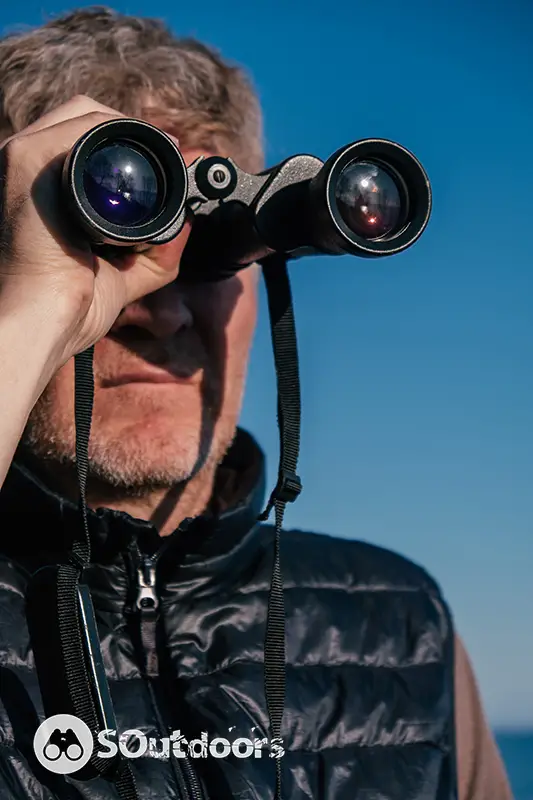
How long your equipment lasts is directly related to how you take care of it during its lifetime. It does not matter how durable an item is if it is not cared for properly. Below is the step by step instructions on how to properly care for your compact binoculars.
Step 1 – Remove all dirt
Also get rid of traces of dust, grit, crumbs and other loose particles on the binoculars by using a soft brush or a compressed can of air.
Step 2 – Use a lens cloth or a tissue with a cleaning solution for the lenses
Using stronger cleaners and chemicals may damage or even strip away the coatings on the lenses.
Step 3 – Wet the lens cloth or tissue with the solution
Start wiping the lenses gently with the cloth.
Step 4 – Wipe lenses
Using a dry lens cloth or tissue, wipe the lenses dry.
Step 5 – Clean smudges
Move or tilt the lenses to the light and look for any smudges, repeat the procedure as needed until no more smudges remain.
.embed-container { position: relative; padding-bottom: 56.25%; height: 0; overflow: hidden; max-width: 100%; } .embed-container iframe, .embed-container object, .embed-container embed { position: absolute; top: 0; left: 0; width: 100%; height: 100%; }
Compact Binocular vs Full-Sized Binocular
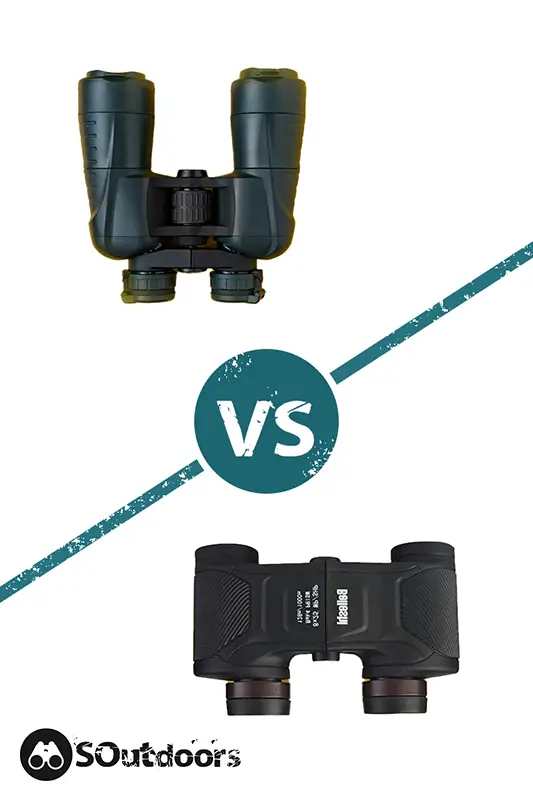
The apparent reason is how portable a compact binocular is. A full-size binocular can have superior magnification that may be overkill for a birdwatcher or a hunter. Not to mention that a full-sized binocular can cost an arm and a leg. Aside from these two activities, a compact binocular would be less awkward to carry inside a sports arena or a concert than its larger counterpart.
Hunting and birdwatching are top-rated sports that take full advantage of the compact size of this kind of binoculars. The compact binoculars are right at home in any hunters arsenal of tools right along with those comfortable hunting boots, the lightweight youth compound bow, and the best wireless and cellular trail camera.
They are also almost always carried by birdwatchers, and their small size makes them easier to whip out when a bird darts into an unexpected place. Having that compound bow that shoots precisely may not be enough, and the situational awareness that a compact binocular affords the hunter is essential to the success of the hunt.
Knowing the lay of the surrounding land will give the hunter that extra knowledge and familiarity to predict where his or her quarry is heading. Aside from the size, though, compact binoculars are entirely at home when you are bird-watching, at a theater show, a sports game, or a concert.
They come in handy in these situations and drives home the point that making sure that you are clear on how and where you will be using the binoculars is a significant factor before considering a purchase. Compact binoculars can be used for hunting, bird spotting, events, or travel and safari.
Does More Spending Mean More Quality
While this may not hold true for each product, this holds true for the majority of brands in the binocular market. Most of the good and great performing binoculars come from reputable brands that have a long history of making products that deal with optics, such as camera lenses and eye lenses. When it comes to compact binoculars, the more expensive it is, the more likely that it will perform and even exceed your expectations.
Do’s and Don’ts With Compact Binoculars
Like all gear, there are a lot of things you can do with a compact binocular and then there are those that you must avoid doing. Just to be clear, here is a list of the things you can or should never do to your compact binocular.
Do’s
- Test all your choices before buying any binocular
- Buy a lens cleaning kit
- Clean your binoculars after use
- Keep them in the carrying case intended for them
- Use a carrying strap or harness for stability and control
- Cap your lenses whenever you store them for later use
- Clean the body of the binoculars and not just the lenses
Don’ts
- Do not use your breath to fog up the lenses just before you wipe them
- Do not use hard-bristled brushes when you clean the lenses as you may damage the coating
- Do not use eyeglass or window cleaners as they might be too harsh
- Do not use one lens cloth for everything, make sure you have a dedicated cloth for lens cleaning
- Do not just store them in any box or case, use the included case or buy an aftermarket case for your particular model
FAQ About Compact Binoculars
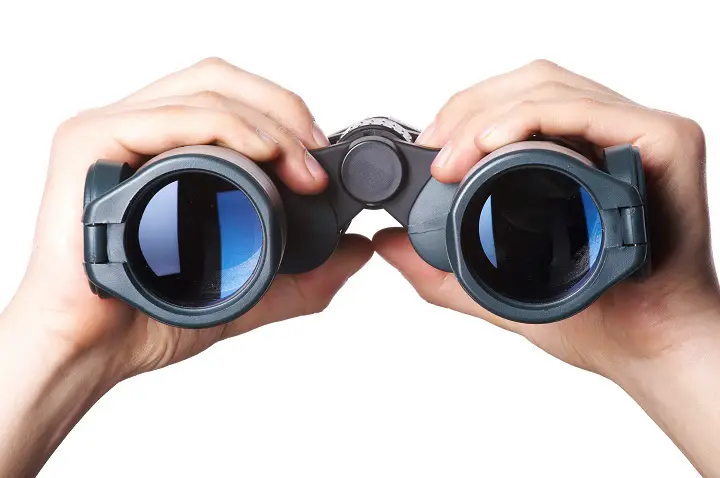
What are the best compact binoculars for bird watching?
The best compact binoculars for bird watching would be those with at least a magnification rating of 7. Anything with over the power of 7 would sacrifice its stability while in use.
What are the best binoculars for sightseeing?
The compact binoculars for sightseeing would be those with larger fields of view and larger exit pupils. For sightseeing, those equipped with a Porro prism system can afford greater depth perception and a superior field of view
What do numbers mean on binoculars?
Binoculars are specified with numbers such as 7x 35 or 8 X 40 and the first number means the number of times the image is magnified from the view of the naked eye. The second number is the measurement of the objective lens which is usually in millimeters.
What are the best inexpensive binoculars?
If you are looking for inexpensive yet great performing binoculars, check for the prism system that they are using. A Roof prism system will generally be less expensive than a binocular that utilizes a Porro system of prisms.
Do the binoculars come with a case or a strap?
Most good quality compact binoculars come with their own carrying case and a strap. You can, however, easily purchase a carrying strap specific to your model with better features for your specific model than the one that came along with it.
Do the binoculars fold down?
Being classified as compact means that compact binoculars will most likely have the ability to be folded down for easier storage options.
Are compact binoculars light enough for kids?
One of the most important features of a compact binocular is that it can easily be used by kids as they enjoy the great outdoors. Most are light enough to pose little to no problems for kids.
Conclusion
The major takeaway here is that one could really never gauge if the particular binocular is the right one for them or not without going through each of the features in person. For one, you can never truly know how comfortable it is to hold. Now that you have read all of the above you will pretty much have a decent idea of what to look for when selecting a compact binocular.
If you hunt or just enjoy the outdoors, you will benefit from a pair of good quality, lightweight, compact binoculars and there is no doubt about it. Once you start carrying them, you will be shocked at how often you reach for them. It may be just to get a better look at a rock formation or something else that catches your eye. Or it may be at your next trophy buck.
All of the old-time hunters carried these amazingly versatile tools for just such occasions. Why we stopped is anyone’s guess but its high time we started this tradition again. With the modern-day price and quality, getting the best compact binoculars is nowhere near as costly or difficult as it has been in the past. Join me and let’s get this tradition restarted!
Photos from: Y-Boychenko / depositphotos.com, Amaviael / depositphotos.com, londondeposit / depositphotos.com, alan64 / depositphotos.com and strelok / depositphotos.com.













First of all thanks for such a great article about Binoculars. It is very helpful for a beginner like me. After reading this post, I am going to pick Nikon Prostaff. What do you say about that?
Thanks for this great article binoculars. it is very helpful for a beginner like me. After reading this I think I am able to understand what is best binoculars-for-beginners